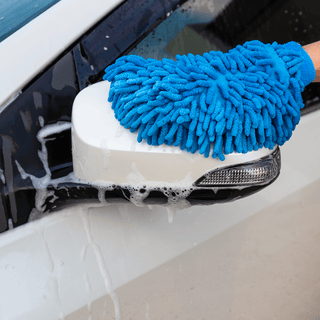The best way to clean the exterior of your vehicle is by doing a proper hand car wash. Yes, I said hand car wash. Washing your car this way will reduce the risk of inducing scratches, swirls, and marring onto the paint’s surface. If you’re someone who doesn’t have access to car washing equipment or water, you can hire a professional car detailer or take your vehicle to a self-service car wash bay. Either way, if you care about your car’s paint and want to keep it looking new, doing it yourself or hiring a professional are the two best options. You’ll want to steer clear of automated car washes because of how badly they beat up your car’s paint; I’ll touch on that later.
Most people don’t have the time or the desire to wash their own vehicle(s). It is a task that requires focus and time if you’re doing it yourself. You have to be someone who really cares about their car to sit outside for an hour or two scrubbing, rinsing, drying, foaming, wiping, and all the other fun steps it takes to clean it. I can tell you that it’s not as bad as you think. Many of my friends in the industry have said it’s therapeutic. Not to make it sound like it’s a walk in the park, but I understand where they’re coming from. It gives you a break from the hustle and bustle of life and after this therapy session, you will have a clean car. It’s a win-win.
Why Hand Washing Rocks
First things first, why choose hand washing over those drive-through car washes? Sure, automated car washes are quick, but they can be a recipe for disaster, especially for that precious paint job. Those harsh bristles will leave your car with more scratches than a cat's favorite scratching post. And don’t even get me started on the broomstick with bristles that hang on the wall at those self-serve washes - those will absolutely destroy your paint.
When you take a wash pad into your hands, you're in control. The gentleness of the microfiber blend in the pad or mitt will help prevent scratches. Again, this is in conjunction with proper car washing techniques. I can’t stress to you enough the importance of using the proper car washing tools. It’ll make the car cleaning experience so much better along with keeping your paint looking new.
Hand washing also lets you spot those trouble areas—like bird droppings or tree sap—and give them the attention they deserve. Using an automated car wash won’t remove all of these contaminants from the paint and over time if they’re not treated properly, you can experience etching in the clearcoat.
Let’s do a quick recap on why you should be out in the driveway washing your car:
-
Customized Care: Hand washing allows you to tailor the cleaning process to your car's specific needs, addressing tricky spots and delicate areas with personalized attention
-
Gentler Touch: Unlike automated car washes that might use rough brushes or harsh chemicals, hand washing lets you control the pressure and use softer materials, reducing the risk of scratches or damage to the paint
-
Thorough Inspection: Hand washing involves getting up close and personal with your car. This gives you a chance to spot and address any issues like scratches, dings, or areas needing special attention
-
Preserve Paint Quality: By using the right techniques and gentle cleaning materials, hand washing helps maintain your car's paint job, keeping it looking fresh and vibrant for longer periods
- Bonding Time: It's not just about cleaning; hand washing can be a bonding experience with your vehicle, allowing you to appreciate its contours, curves, and unique features while giving it the care it deserves
How to Wash Your Ride
There are a few things you want to do before washing your car. You want to start by parking in a shady spot to avoid water drying on the paint. Many of us detailers have our own unique perspective on whether you should rinse your car first and then foam it second or the other way around. I, personally don’t see either way as being incorrect. Some will say that rinsing the surface first will dilute the soap you're going to apply to the paint. That may be true, but I also haven’t witnessed a car not being as clean doing it this way. I do understand the concept behind applying foam to the car’s paint first because you’re allowing the soap to do the cleaning followed by a thorough rinse. Honestly, do what you want here and find what works best for you.
I usually like to start by washing the wheels first, since this will be the dirtiest part of the vehicle. These are the steps I take:
- Rinse the wheel thoroughly using either a garden hose or pressure washer
- Spray onto the tire a wheel cleaning chemical that will attack the brake dust and grime. I’ll usually let the product sit on the wheel for a minute or two to let it do its job
- Use the proper wheel-cleaning tools to remove all the nastiness off the wheel face, wheel barrel, and wheel well
- The final step would be to rinse off and then move on to the next wheel
I will tell you that this is probably the longest part of the car washing process. I can easily spend 45 minutes doing this process. Sorry, I’m a detailer.
After doing the wheels, I will then move to washing the car itself. This is the fun part. Why? Because you get to foam. Everyone loves to foam their car including me.
-
Rinse: Start by giving your car a rinse with a garden hose or pressure washer to get rid of the loose dirt
- Foam: Grab your foam cannon and fill it up with your favorite car washing soap then blanket the car completely. Remember, you have the option to foam your car first while the paint is dry instead of rinsing it first. Let the soap sit on the paint for about five minutes; you can prepare your wash and rinse buckets while this is going on
-
Rinse Again: After the soap has been on the paint for about five minutes, you can now rinse it off
-
Foam Again: You’re probably wondering why the heck are we foaming again. Well, it’s to add lubrication to the surface before your contact wash. This is a good technique to follow to prevent any scratching on the paint. Remember, we want to take every precaution we can before touching the surface with our wash mitt
-
Contact Wash: Now, it’s time to pull out your car washing buckets (wash and rinse) and go to town. Here is where we’re dunking our wash mitt/pad into the wash bucket and gliding it across the paint to remove any leftover dirt that the foaming process didn’t get. You want to be sure you’re not pressing into the paint; let the soap and mitt do the work. Also, don’t forget to work from top to bottom
-
Final Rinse: You’ve done your contact wash and now you’re ready for your final rinse. Grab your garden hose or pressure washer and rinse off any remaining soap
- Time to Dry: Let’s now get that paint dry by using our leaf blower or drying microfiber towels. This step is pretty straightforward. Just get the thing dry!
So, there you have it, friends! Hand washing your car might involve a few steps, but trust me, it's worth it. These little acts of TLC prevent those dreaded swirls and scratches, and keep your car's paint looking like it just rolled out of the showroom. Remember, it's not just about cleanliness—it's about preserving that sleek, shiny look that turns heads on the road. So, grab your sponge, follow these steps, and show your car some serious love. Your paint will thank you for it! For more tips on how to wash a car while preventing swirl marks and protecting car paint, keep reading and keep your wheels looking fresh!

